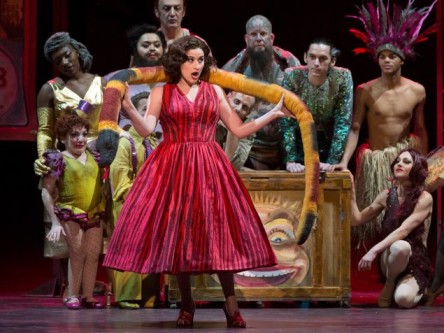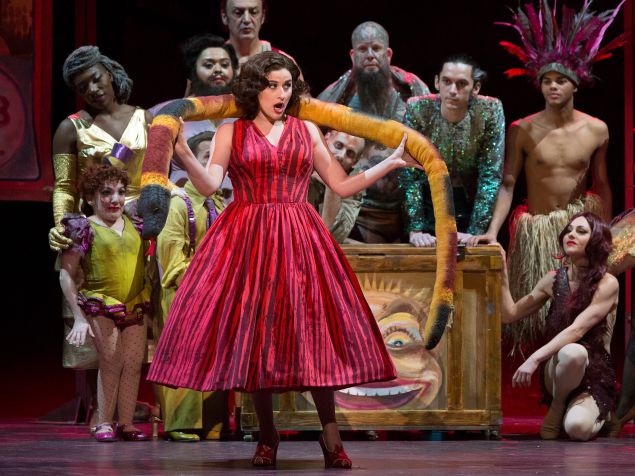 United States Mozart, Così fan tutte: Soloists, Chorus and Orchestra of the Metropolitan Opera, New York / David Robertson (Conductor), Broadcast live to the Dundonald Omniplex Cinema, Belfast, from the Metropolitan Opera, New York, 31.3.2018. (RB)
United States Mozart, Così fan tutte: Soloists, Chorus and Orchestra of the Metropolitan Opera, New York / David Robertson (Conductor), Broadcast live to the Dundonald Omniplex Cinema, Belfast, from the Metropolitan Opera, New York, 31.3.2018. (RB)

Cast:
Fiordiligi – Amanda Majeski
Despina – Kelli O’Hara
Dorabella – Serena Malfi
Ferrando – Ben Bliss
Guglielmo – Adam Plachetka
Don Alfonso – Christopher Maltman
Production:
Production – Phelim McDermott
Set Designer – Tom Pye
Costume Designer – Laura Hopkins
Lighting Designer – Paule Constable
Live in HD Director – Gary Halvorson
Live in HD Host – Joyce DiDonato
Così fan tutte was Mozart’s third collaboration with Lorenzo Da Ponte and it has always been subject to allegations of misogyny given its seeming depiction of women as emotionally superficial and fickle. In the 19th Century the opera was rarely performed as many took the view that the subject matter was vulgar but it came back into favour again in the 20th Century. While Da Ponte’s sisters can come across as rather two dimensional on the printed page, Mozart provides them with some of the most ravishing music ever written. It somehow makes their emotional switch in allegiances more authentic and it raises profound questions about how real the feelings and emotional attachments of the two women are. While it is true that their male lovers have carried out a cruel deception at their expense, Ferrando and Guglielmo seem to be more wounded than their female partners. At the end of the opera, there is always a sense of unease, notwithstanding the happy ending. Mozart and Da Ponte have raised profound questions about the nature of the human condition and there are no easy solutions or quick fixes.
Any production of Così must be judged by the way in which it illuminates this very complex set of issues at the heart of the opera. Phelim McDermott’s production transfers the action from 18th Century Naples to Coney Island in the 1950’s. During the playing of the Overture, a magic box was placed in the centre of the stage and a group of circus performers emerged, including dwarves, a strongman, a bearded lady, a contortionist, a fire eater and two sword swallowers. Each of them held up cards first telling the audience to be quiet during the playing of the Overture and then displayed messages commenting on the opera. This group became Alfonso’s co-conspirators and they helped facilitate the action at various points in the opera and we saw their routines as the lovers moved around Coney Island.
Tom Pye’s set designs were impressive and transported us to a rather surreal version of Coney Island in the 1950’s. When the sisters first encountered their lovers in disguise, they were in motel rooms which revolved to allow the audience to follow them as they entered and left rooms. The amusement park at Coney Island featured an array of fun fair rides. During Fiordiligi’s Act II aria, Amanda Majeski entered a spherical fun ride and was hoisted into the air, seemingly alone against the night sky. The effect was a spectacular coup de théâtre and emphasised the isolation and vulnerability of the character at that point in the opera.
Laura Hopkins’ costumes were impressive and eye-catching and they added a splash of colour to the evening’s proceedings. When we first encountered Ferrando and Guglielmo they were wearing dashing naval officer costumes. When they came back in disguise they wore moustaches and resembled Travolta-type characters from Grease. Kelli O’Hara’s Despina wore a rather striking cowboy outfit in Act II when she came back disguised as the notary and was flanked by two dwarf cowboys. Christopher Maltman’s Alfonso was wearing a mustard-coloured suit and changed to a red spangled outfit for the wedding scene.
A huge amount of work and craftsmanship has clearly gone into this production but it did not entirely work for me for two key reasons. First, on a number of occasions, the theatrical effects proved distracting and diverted attention away from the music and main characters. Majeski’s Fiordiligi seemed to walk in and out of the doors of her motel room in a rather pointless way during the singing of ‘Come scoglio’, for example, and it all proved very distracting. The circus performers also proved distracting in some of the scenes staged at Coney Island. Secondly, while the circus performers, sets and costumes all lent a splash of colour and frothy exuberance to the opera they did not illuminate the motivations of the characters in any meaningful way or lend any fresh perspectives or insights to Così.
So how did the performers fare in this production? Amanda Makeski was wearing glasses for most of the opera and she presented us with a rather bookish and buttoned-up Fiordiligi. The glasses were removed for the final romantic scenes with Ferrando and she was transformed into a much more sensual woman (think Liv Ullmann’s transformation in Bergmann’s Autumn Sonata). The technical execution of ‘Come Scoglio’ was excellent and she showed herself an adept performer across the vocal range although the performance was a little cautious and I would have liked a greater sense of freedom and momentum. She sustained the vocal line beautifully in ‘Per pietà’ and gave a very heartfelt and moving performance. Ben Bliss portrayed Ferrando as a convivial and gallant naval officer before transforming him into a laddish greaser, complete with tight jeans and tattoos. He gave us some of the best singing of the evening and his performance of ‘Un’aura amoroso’ in particular was ravishing. Majeski and Bliss combined to great effect for a superb performance of ‘Fra gli amplessi’ which captured the drama and sensuality of that great duet brilliantly.
Serena Malfi portrayed Dorabella as a spirited and winsome character and she provided us with well executed singing throughout the evening. Her rendition of ‘E amore un ladroncello’ was upbeat and ebullient and her bubbling sense of enthusiasm carried all before her. Adam Plachetka’s Guglielmo was a laddish and unsophisticated character who had no qualms about boasting of his prowess with the ladies. He has a rich, sonorous voice and produced robust, virile singing throughout the evening. Christopher Maltman’s Alfonso was a sneering, conspiratorial figure who seemed to enjoy watching the emotional entanglements of the four lovers. He has a very rich, seasoned voice which he put to excellent use in the ensemble numbers. Kelli O’Hara is a Broadway performer and this was her first foray into opera. She gave a rounded portrayal of the worldly-wise Despina and displayed excellent comic timing. Her singing was extremely good, both in the two arias and in the ensemble numbers so one can only hope that we will see more of her at the Met in future.
David Robertson kept a tight grip on the evening’s proceedings. He ensured the orchestral textures remained clean and light and there was an excellent balance and rapport between the orchestra and the soloists. Some of the ensemble numbers were exceptionally fine, including ‘Soave sia il vento’ where whispering strings gave way to heartfelt lyricism from the soloists. The Act I finale had drive and dynamism but some of the tempi were a little fast and I would have welcomed a more graduated build up to the final Presto. The Met Orchestra were firing on all cylinders throughout the evening and I was particularly impressed with the woodwind who did an excellent job capturing the zest and fun of the score.
Overall, I was not entirely convinced by this production but it was redeemed by some very fine singing and playing.
Robert Beattie
For more about the Met Live in HD click here.

Despite the lovely music, I found this a disappointing production. My evening was marred by the updating and the funfair setting; childish captions during the overture; some terrible sub-title translations and. the ridiculous portrayal of one of the sisters singing from a circulating “hot-air balloon” more reminiscent of an episode of “Celebrity Come Dancing”. At no time was I emotionally involved in this farcical portrayal. So please in future….”If it ain’t broke, don’t fix it.” What next – Hamlet on roller skates?